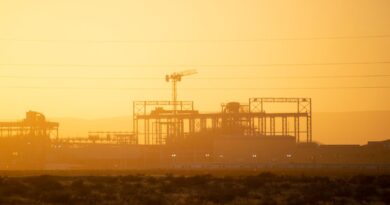Sibanye Stillwater: Rustenburg operation produced 1% more PGM
4E PGM production from the Rustenburg operation for Q1 2025 of 199,591 4Eoz, was 1% higher year-on-year with underground production of 185,811 4Eoz 2% higher and surface production of 13,780 4Eoz, 17% lower due to adverse weather impacts on throughput. Production from the Siphumelele mine, which was impacted by restructuring and the shaft bin incident in March 2024, increased by 53% or 4,475 4Eoz to 12,866 4Eoz for Q1 2025. Production from the mechanised Bathopele mine was impacted by lower grades and poor ground conditions intersecting the decline development and a planned decline in production (7% or 2,970 4Eoz lower) as the shaft approaches the end of its reserve life. Production from the Klipfontein opencast mine declined by 56% or 2,048 4Eoz compared to the prior period due to the ramp-down of mining from the current pit. An environmental permit to extend the Klipfontein opencast mine by a further year was approved during March 2025, with production expected to ramp-up during Q3 2025. The historical Kroondal underground shafts have recovered with production increasing by 8% or 4,744 4Eoz year-on-year. AISC for the Rustenburg operation of R25,131/4Eoz (US$1,360/4Eoz) for Q1 2025 increased by 17% year-on-year, primarily due to lower surface production and the Kroondal operation incurring smelting and refining costs following the change from a PoC to toll processing arrangement with effect from 1 September 2024.
By-product credits declined by 36% to R1.0 billion (US$56 million), primarily due to the 20% lower average chrome price and 27% lower chrome sales. Also contributing to higher AISC was ORD expenditure increasing by 21% to R175 million (US$9 million) as a result of higher direct development and shaft services costs at the Thembelani mine and an increase in ORD at the Siphumelele mine, from lower ORD for Q1 2024 due to the shaft incident.
Marikana operation
4E PGM production of 158,099 4Eoz from the Marikana operation (including PoC) for Q1 2025 was 10% lower year-on-year, with PoC production of 17,753 4Eoz, 31% lower than planned. Production (excluding PoC) of 140,346 4Eoz was 6% lower year-on-year, with production from underground of 134,871 4Eoz, 5% lower and surface production of 5,475 4Eoz, 28% lower due to the excessive rain reducing throughput and plant recoveries due to plant instability.
Underground production was impacted by the closure of 4B shaft in Q2 2024 (7,641 4Eoz lower year-on-year) and a S54 stoppage at the Saffy shaft, which was only lifted on 21 January 2025, resulted in 21% or 9,962 4Eoz lower production compared with Q1 2024. This decline in production year-on-year, was partially offset by higher production from K4 shaft which increased by 11,415 4Eoz to 22,004 4Eoz, consistent with the planned build up.
AISC (excluding PoC) declined by 8% to R24,375/4Eoz (US$1,319/4Eoz) compared to Q1 2024 and AISC (including PoC) of R23,783/4Eoz (US$1,287/4Eoz) in Q1 2025 was 7% lower year-on-year, with PoC purchase costs 16% lower to R496 million (US$27 million). Q1 2025 AISC was inflated by the inclusion of a once off adjustment to legacy leave liability provisions, which added 2,492/4Eoz (9%) to Q1 2024 AISC. By-product credits increased by 19% to R1.3 billion (US$72 million) for Q1 2025, equivalent to an R8,379/4Eoz (US$453/4Eoz) AISC benefit, primarily due to 15% higher credits from ruthenium sales and 119% higher credits from iridium sales compared with Q1 2024.
ORD spend for Q1 2025 declined by 7% due to lower primary development with the exception of K4 shaft where primary development increased by 13% year-on-year. Sustaining capital increased by 35% to R204 million (US$11 million) predominantly due to surface infrastructure enhancement projects to facilitate a transition to new feed sources and expanded tailing storage facility (TSF) infrastructure.




